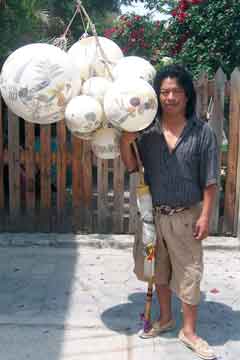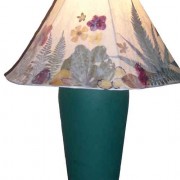Just call me Indio
One of Panajachel’s most colorful and asked-about personages, tourists and locals know him as a master craftsman who sells his own handiwork.
Self-promoter, religious huckster, iconoclast, “loco”—Francisco Quiej has been called all these things; none is anywhere near the truth. “Indio” is what he calls himself, even though his fellow Mayas consider the term an insult.This renaming took place in 1994 on a mountaintop. Francisco saw no burning bush on the slope, but “in my heart there was a burning conviction that I should wear this name.” Indio has since climbed summits throughout Central America, seeking prime meditation venues.
“That name carries 500 years of baggage,” he says. “Being pejorative, it’s also purifying, because as a bad name it obligates me to better myself, by doing right by others. Then I can wear it as a badge of shame and pride, at the same time.” It may be working; Indio is well spoken of by those who actually know him.
He is native to Zunil, a K’iché town near Quetzaltenango, where his parents were members of the “agricultural caste.” Even so, his father completed school and became a teacher; Indio and his five siblings therefore grew up in a literate household.
Indio is today one of Panajachel’s most colorful and asked-about personages. Tourists and expats know him as a master craftsman who sells his own handiwork: spherical lampshades by the cluster that waft, cloudlike, up and down the Santander Strip, turning heads.
His long hair sets him apart as well, since modern Mayan men rarely let their locks grow. Indio counts no connection with the hippies of nearby San Pedro la Laguna, as some observers think. His hirsuteness instead recalls the Nazarite vow of his first-century heroes such as John the Baptist and Simon the Zealot. Since most scholars believe that Jesus of Nazareth was also a Nazarite, medieval artists and Hollywood alike portray him with a haircut eerily like Indio’s.
Since Indio seeks to imitate his messiah in all things, he sees evangelism as his primary calling. This makes him one of among thousands of itinerant preachers in Central America; unlike most, however, he employs handiwork as a vehicle. He does not judge those who preach on buses and then request money, but he says that they need to “discover their trade and enter it as a step of faith.” Paul of Tarsus, he recalls, was a tentmaker. Indio sees his own craft as a divine gift along this line, and therefore nothing to boast about, even as he plies it and wins admiration.
He discovered the gift in the same way he discovered the name: on a mountaintop, this time in Costa Rica in 1997 while a member of an artisan commune. “While meditating, I was suddenly aware of the plants growing around where I sat. I began examining them and imagining uses for them.” Since he was at a high altitude, many of them were alpine ferns; today, fern fronds are a staple in his designs.
“That night, after coming down from the mountain and turning in, I dreamed of two blonde women. I don’t remember any details, but when I awoke, I knew I had a direction to launch a craft.”
The dream’s significance, he says, was that “foreigners were the door. Guatemalans had no interest in my lampshades, at first.” Most still do not, he thinks, because they see them as something non-ladino and, he adds with an ironic smile, “non-indio.”
Foreigners remain the bulk of Indio’s clientele, so it helps to hang his hat in cosmopolitan Panajachel. Yet Guatemalans are warming up to his work.
Local hardware stores sell tacky porcelain lamps from China, but panajachecos increasingly see Indio’s work as authentic and even voguish. Restaurants all over town have become his showroom. Most tourists choose the standard “small” lamp, a 16-centimeter orb that travels well in suitcases. For everyone else, sizes go all the way up to room-gobbling “gigantic” at 63cm. Other shapes can be special-ordered.
One wall of Indio’s living room is filled with newsprint stacks, where leaves and petals undergo desiccation. His charming French wife, Luz—called Catherine before her own conversion and rechristening—churns out hospitality an arm’s-length away in her tiny kitchen, tottering with herb jars. The couple, who met in Costa Rica, have two polygot daughters with creamy, mixed-blood complexions. Abril, 11, and Michelle, 9, show no inclination to adopt their father’s trade. But even they call him Indio.
Indio spends part of every selling day pounding the streets. But he is no in-your-face peddler; his product provides the draw. He often starts his selling day in uptown Panajachel’s mercado, where there are people, he says, who need to hear his message, or who need comfort and encouragement. Most itinerant evangelists speak and gesticulate like preachers at all times. But Indio, always the exception, switches at will between “preaching mode” and “normal conversation.” Nonreligious people are surprised to find, when they get to know him, that he is capable of both.
“I guess I’m all about light,” he says. “I sell lampshapes that soften electricity’s glare, so I can share the light of el Señor.


Pingback: September 2008 in Revue Magazine | Revue Magazine
Keep it going, Wayne, nice interesting articles.